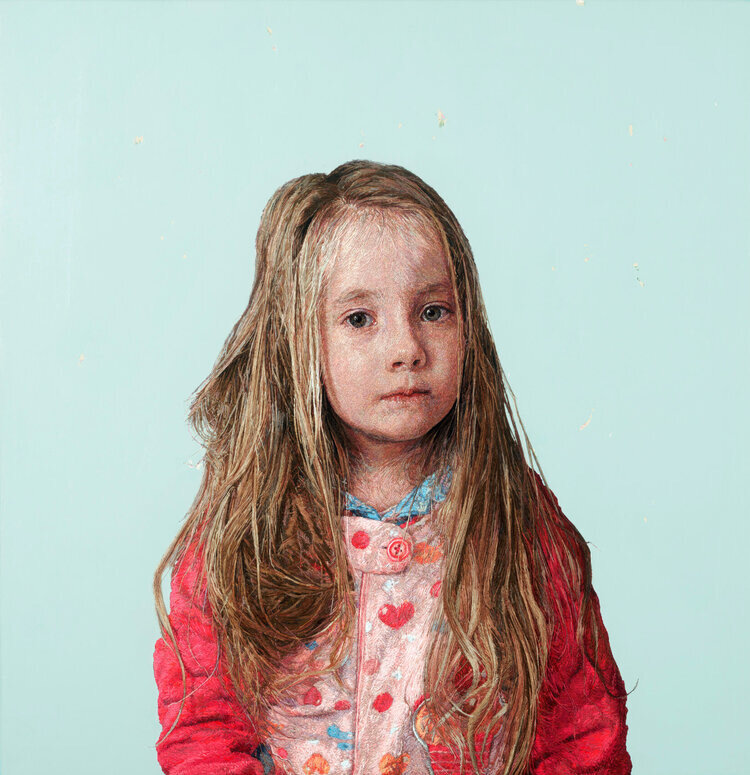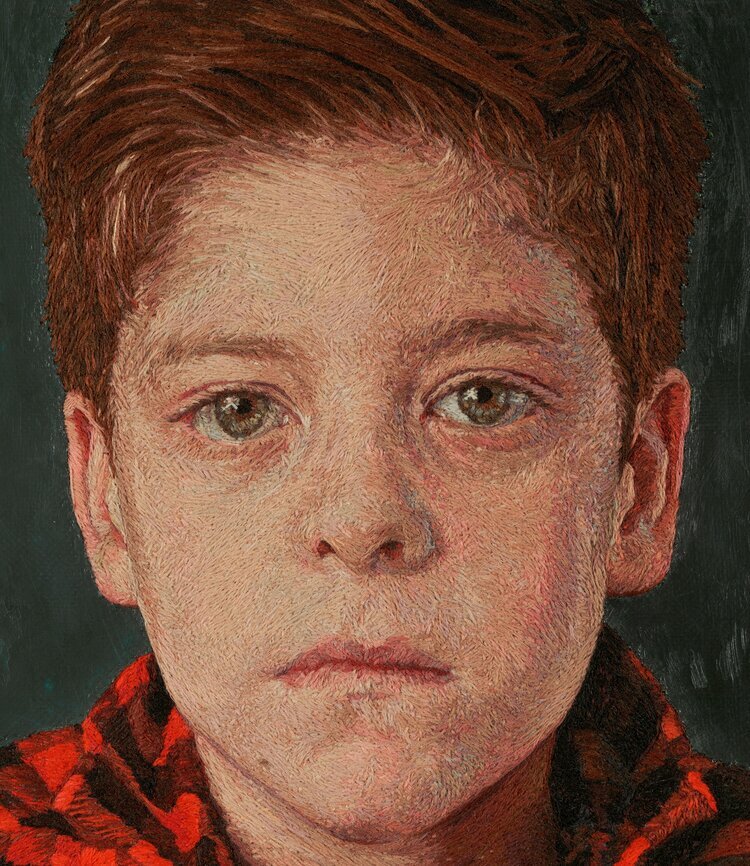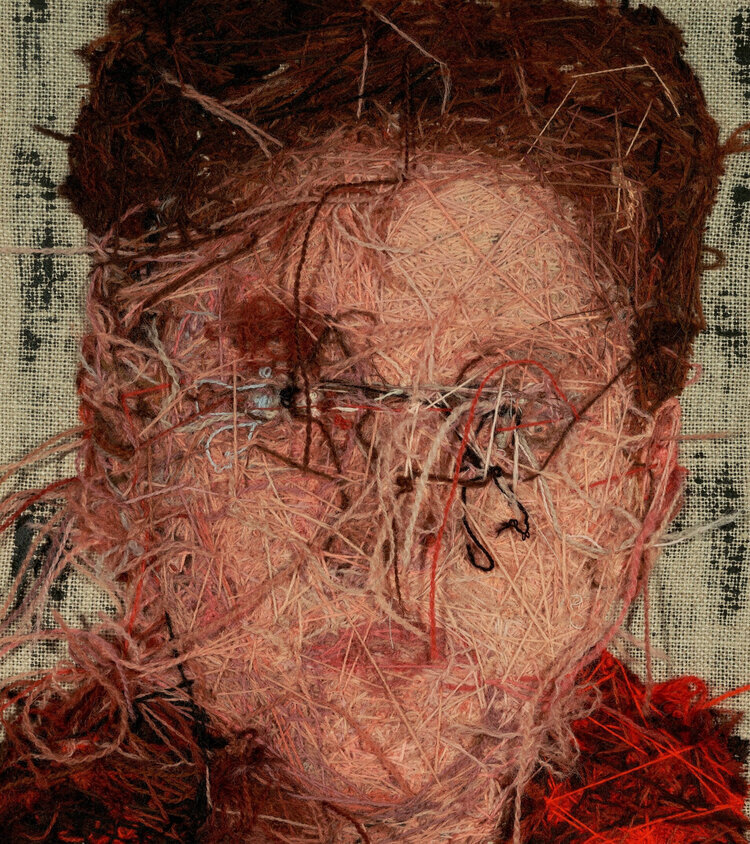For nearly two decades, Cayce Zavaglia has employed embroidery to create arresting portraits that hover between photorealism and impressionism. Originally trained as a painter, her sensitivity to color and mark are evident in her intimate portrayals of friends, family, and fellow artists.
Zavaglia received her BFA from Wheaton College and her MFA in painting from Washington University. She mounted her first museum solo at the Contemporary Art Museum St. Louis in 2014. Zavaglia is represented by Lyons Wier Gallery in NYC and William Shearburn Gallery in St. Louis.
For more information, please see: caycezavaglia.com, William Shearburn Gallery, and on Instagram @caycezavagliastudio.
Cayce Zavaglia, Emmylou (recto), 2019. Hand Embroidery: Crewel Wool on Belgian Linen with Acrylic. 30 X 28 inches. Image courtesy of the artist.
First, and most importantly, how are you doing? How are you navigating the highs and lows?
I am doing fine. I am home with my husband and 4 kids in Saint Louis, Missouri. My studio is on the third floor of our home and I’m trying to stay busy even though I’m finding it really hard to concentrate. I quickly lowered the expectation for myself in regards to studio hours and instead am just trying to get a good 3-4 hours of work done per day. I have been enjoying this time with my family …cooking and doing mundane chores to relieve the stress of these stressful times. I’ve been navigating the lows with fine chocolate, baked goods, lots of homemade Asian food, and an iced espresso with almond milk every morning at 10.
I feel like this whole experience of quarantine, covid, and the Black Lives Matter marches has been a time of sifting…distilling everything down to the essentials and what’s the most important. I am confident it comes down to family, our health, and loving our neighbors as ourselves. Nothing else seems like a “high” right now…it’s the essentials of life at their simplest form that constitute daily “highs”.
Cayce Zavaglia, Emmylou (recto detail), 2019. Hand Embroidery: Crewel Wool on Belgian Linen with Acrylic. 30 X 28 inches. Image courtesy of the artist.
It's my experience that most artists engage with some level of self-isolation in their day to day art practice. Has this been your experience? And if so, have you found these innate rhythms to be helpful during this larger, world-wide experience of isolation?
Yes, I am always in isolation and work with no assistants...so the house and studio is quiet from 7:30-3:30. The difference is that I now have 4-5 other humans in and out of my space and so am operating as both an artist/mother...and a cruise director of sorts. There is beauty in listening to their stories, being willing to stop in the middle of something to be with them, and I am confident that all of this will ultimately feed into my work. I have always believed that having kids informs one’s work rather than detracts from it.
Cayce Zavaglia, Emmylou (recto detail), 2019. Hand Embroidery: Crewel Wool on Belgian Linen with Acrylic. 30 X 28 inches. Image courtesy of the artist.
It would be great if you could briefly talk us through your practice. Understanding it is integral to appreciating the multivalence of your work.
I was trained as a painter and received my BFA and MFA in painting. As a result, I still consider myself a painter and look mainly to painters for inspiration. Even though I have been working with embroidery for close to 20 years.... I can’t embrace the title of “Fiber Artist”. I think for so long that “Fiber” was really the “F” word of the “art world” and was not fully embraced. It is a whole different world today and thankfully those lines are blurring. My work is about documenting my family and I don’t take on any commissions. I made the decision to concentrate on my own family right around 9/11... when I was pregnant with my first child. The events of September 11th sucked the wind out of our world and at the end of the day all that mattered to everyone was love and their family. As an artist, it can be very overwhelming to pin down what you want to make art about. I have chosen to make portraits of just my family...I fully believe there is enough material there to sustain a practice for my entire lifetime. My work has also been interested in both the portrait and the process. My work is about specific people, but I want there to be an equal interest in how I construct the work. I want my embroidered portraits to read as paintings from a distance...and then as you inspect them closer you realize they are actually sewn. A few years ago, I turned one of my embroideries over and fell in love with the verso image. A much more abstracted portrait that was the by-product of the meticulously sewn front image. These images are now the source of inspiration for a series of small gouache, large acrylic paintings, and wall sized verso embroideries that speak to this “other” side we each possess.
Cayce Zavaglia, Emmylou (verso), 2019. Hand Embroidery: Crewel Wool on Belgian Linen with Acrylic. 30 X 28 inches. Image courtesy of the artist.
Has any of your imagery shifted in a reflection to what's currently happening? Or are you considering using coronavirus related imagery for future projects? Do you find it necessary to make work about the pandemic? And why, or why not?
I was already underway sewing a large 6ft. square embroidery when sheltering in place commenced. I’m grateful that I had this piece already on the go...as it has allowed me to keep my hands busy while my mind wanders. I’m not interested in corona virus imagery but I am interested in the idea of touch. Museums have been abiding my covid regulations for centuries: You cannot touch the art, you must stand 6ft away from work, masks and gloves must be worn by those handling the work, and the most sensitive work never leaves the museum or sees the light of day because it is too fragile. This large embroidery I am making has acrylic painted areas, large areas of handembroidery, bits of vintage embroidery, handmade and color specific pom-poms, and sequins sewn across the piece. It is a celebration of textures and a nod to my childhood love of craft that is just begging to be touched. It might take some convincing with my dealers, but I’m contemplating the idea of letting the viewer touch the work. I don’t find it necessary to make work about the pandemic, but I do think of other things somewhat related to the pandemic. After 9/11 there was a return to craft in art: embroidery, weaving, tapestry, cross-stitch, knitting, woodworking, and clay. I think that was because there was a sense of comfort in returning to these things that you saw or were exposed to as a kid. Maybe a Grandma or Grandpa showed you how to do these things. I am fully expecting the same thing to happen post covid. This pandemic is ultimately a time of sifting. The unimportant things will fall to the floor and only the stuff of substance should remain. I know for me and the verso series of work that I am engaged in....I’m wanting to speak more universally to who we are at our very core and speak to this “other side” ...the side that no one sees. It is knotted and messy but also has the potential for beauty. In our culture, we string together a series of letters, pronouns, and words to paint a picture of who we are to those around us. Art, however, is for a time when there are no words. The pandemic and the recent protests have reignited the desire to find an image that captures who we all are when words are stripped away. What does that portrait look like when we can’t use words or labels to help define who we are. Who we are we beyond our sexuality, race, religion, or political persuasion and how do I depict that in art. What would that portrait look like?
Untitled work in progress, 2020. 72 x 72 inches. Image courtesy of the artist.
Are you thinking differently? Coping differently? Inspired differently?
I’m thinking deeper about some of the same concerns. I’m thinking about how I love mark making more than drawing and how best to play to my loves and strengths. I’m thinking about how much I dislike cross-stitch, but how I would love to do something with it as a challenge for myself. I’m shopping my own studio and using materials from the craft store that I have never incorporated into work. I am experimenting and playing with dye, bleach, ink, vinyl, and cyanotypes. I feel like I’m coping by doing and folding more laundry, walking and stretching, laughing, trying new recipes and not feeling guilty about eating ice cream. In response to the protests and in support of Black Lives Matter, I have started making hand written and embroidered “protest patches”. One day I was compelled to simply write out “Black Lives Matter” and stitch it in black thread. I just felt it was something I should do. I offered it up on my Instagram feed to whoever would like it. From there I started writing out phrases, words, or quotes that were positive and in support of BLM…and have continued to post and give them away for free on my Instagram account. It is very therapeutic to make them and getting real mail in the mail has been something that everyone craves right now.
Cayce Zavaglia, UNSEEN, 2019. Hand wool embroidery, acrylic paint, pom-poms and sequins on raw Belgian linen. 84 x 72 inches. Image courtesy of the artist.
Cayce Zavaglia, UNSEEN (detail), 2019. Hand wool embroidery, acrylic paint, pom-poms and sequins on raw Belgian linen. 84 x 72 inches. Image courtesy of the artist.
What do you think or hope will be different after this crisis has passed?
I am hoping there will be more love and less hate in our world. I am hoping we will buy less and waste less. I am hoping people would let go of their anger. I am hoping that people will keep baking sourdough bread and still eat at home with their family.
I’m hoping that the art world will be slower. That it would be more patient to wait for work from artists instead of imposing great pressure on them to produce, produce, produce. I actually love Art fairs because you are allowed to get up close and personal with the work...but I’m hoping this model changes because artists have started making work according to the timeline of the art fair circuit instead of to their own studio rhythm.
I’m hoping that the art world would look beyond the coasts for artists making great work. Instagram allows curators, critics, and collectors to travel every day beyond New York, LA, and London to see the work of unknown, emerging and blue chip artists...and yet those are still the top cities in the art world. There are thousands of talented artists that live in the middle of America.
Installation view of UNSEEN, 2019. Hand wool embroidery, acrylic paint, pom-poms and sequins on raw Belgian linen. 84 x 72 inches. Image courtesy of the artist.
I am hoping the phrase “womens work” would die. I am unabashedly a woman doing “women’s work” as part of my art practice. Unfortunately, the male artist incorporating “women’s work” is still more visible and are considered a novelty in the art world. Their story is that their mother or grandmother taught them to sew/knit/weave. This is the same story coming from female artists who incorporate craft...and I’m still boggled why this stereotype remains in the art world. I’m hoping this changes...especially as many artists will re-enter the art world with new works for sale made primarily with things lying around their homes. Work that was made while they juggled many things at once.
I’m hoping most of all that the artist/mother would be investigated and valued in the art world. I have only ever heard L.A. based curator Helen Molesworth validate the voice of the artist/mother in her lectures and research. She has studied the life of Ruth Asawa in great detail. Asawa was a mother of 6, had her studio in her home, exhibited in her home, and was a housewife. Molesworth has so bravely questioned: “What does being a mother have to tell us (the art world) about what it means to be an artist?” Why is the artist/mother one of the last taboos in the art world? Now that everyone has literally been in their homes for the last few months... I’m hoping that there is a greater appreciation for the artist/mother in the greater Art World and I’m hoping that many curators would start now seeking out the “Asawa’s” of tomorrow.... those who are currently home and making while surrounded by kids... I’m hoping that they will be seen...as they are only a few clicks or a google away.
Cayce Zavaglia, Luca 2020 (recto), 2020. Hand Embroidery: Crewel Wool on Belgian Linen with Acrylic. 7-3/8 X 8-3/4 inches. Image courtesy of the artist.
What is bringing you solace, or even joy, in this moment?
1. Making my protest patches and working on my first magazine cover.
2. Knowing that my family is healthy and safe.
3. Having my college aged daughter home. She is a vocal performance major and so her singing is the soundtrack to my studio.
4. Watching Clint Eastwood movies with my 17-year-old.
5. Seeing my 14 year olds hair grow so long that it sprouted his childhood curls.
6. Embroidering side by side with my 11-year-old.
7. Early mornings drinking Lady Grey tea and having a whiskey sour on a Wednesday.
Cayce Zavaglia, Luca 2020 (verso), 2020. Hand Embroidery: Crewel Wool on Belgian Linen with Acrylic. 7-3/8 X 8-3/4 inches. Image courtesy of the artist.
What research or writing are you doing that you find compelling?
I’m crushing hard right now on Roy Lictenstein and revisiting and researching the Ben Day dot. I had no idea that the dot was created in 1879! I always thought that it was a 50’s and 60’s invention. I heard Lichtenstein talk at the Dallas Museum of Art in 1995 and hadn’t given him much thought in the last 20 years...but am interested in revisiting the dot in my own work. My embroidery is a kind of a pointillist approach to embroidery and I have used pom-poms as a sort of circle/dot in my work...but I’m interested in seeing what else I could do to push the dot in my work.
Untitled work in progress (detail), 2020. 72 x 72 inches. Image courtesy of the artist.
What are you reading?
I’m not much of a reader, but I recently finished Ninth Street Women. I’m currently reading Lucien Freud: The Restless Years and also working my way through the coffee table book Vincent Van Gogh: The Drawings. I also listen to lots of podcasts and art lectures while I’m stitching and I count these as my “reading hours”.











